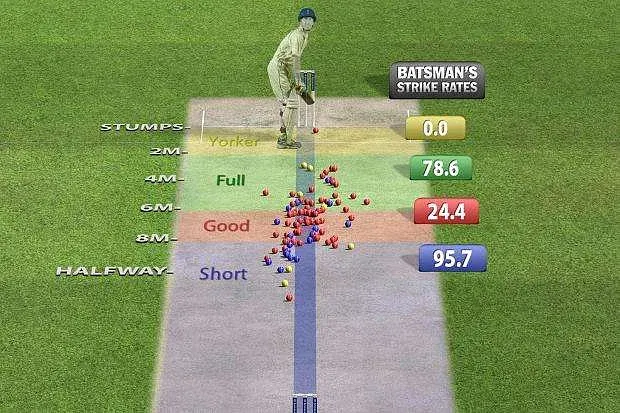Why bother about the ball line, length and speed in cricket?

Measuring ball line, length and speed is improtant in cricket to understand and improve a player’s bowling or batting. Before we get in to how these metrics are captured and analysed here is a quick snapshot of what they mean:
- Ball line: The ball line refers to the path the ball takes as it travels towards the batsman. It is important to measure the ball line because the bowler is only allowed to bowl within a certain area known as the "line of the stumps." If the ball goes outside this area, it is considered a wide and the batting team is awarded an extra run. Measuring the ball line helps the umpire determine whether a ball is a wide or not.
- Ball length: The ball length refers to how far the ball bounces before it reaches the batsman. The length of the ball can affect the difficulty of the shot that the batsman needs to play. Measuring the ball length can help the batsman and the fielding team adjust their tactics and strategies accordingly.
- Ball speed: The ball speed refers to how fast the ball is bowled. Measuring the ball speed is important because it can help the batsman anticipate the trajectory of the ball and play the shot accordingly. It can also help the fielding team set up their fielding positions and make adjustments to their bowling tactics.
There are different methods to measure the ball line, length, and speed in cricket. Here are some of the most common methods used:
- Ball line: The umpire standing behind the wicket can visually judge the ball line and call a wide if the ball goes outside the line of the stumps. There are also electronic systems such as the Hawk-Eye technology that uses cameras to track the path of the ball and determine if it's within the line or not.
- Ball length: The length of the ball can be judged by the batsman or the fielders based on their visual assessment of how far the ball bounces. The length can also be measured using a pitch marker, which is a line drawn on the pitch to indicate where the ball bounces.
- Ball speed: The ball speed can be measured using a radar gun, which uses radio waves to measure the speed of the ball as it travels towards the batsman. The radar gun is typically operated by a trained operator positioned behind the bowler's arm. Another way to measure ball speed is through the use of video analysis, which involves capturing the ball's movement using high-speed cameras and analyzing the footage to calculate the speed.
Overall, measuring the ball line, length, and speed requires a combination of visual judgment and technology, and the accuracy of the measurements may vary depending on the method used.
But what about for aspiring cricketers and clubs at the grassroots? How can they measure and analyse ball line, length and speed for their advantage?

We built HomeGround (www.homegroundapp.com) to help apsiring cricketers get access to quality coaching for as little as $3 right on the smartphone without a need for wearables or sensors, all the player or coach has to do is upload/capture live training videos to get instant metrics.
Our vision with HomeGround is to help the 200 Million cricketers worldwide afford quality coaching and help they play the game they love the most
Give us a try and let us know how we can improve to help in your training journey.

